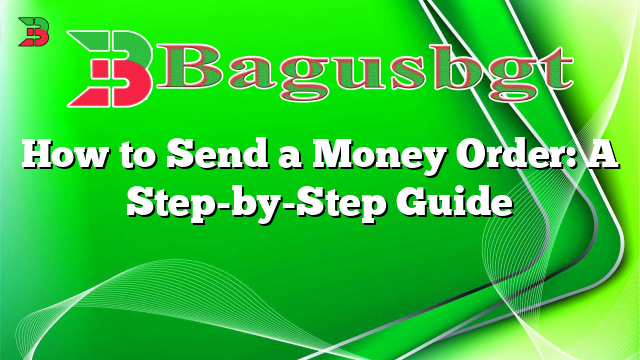Hello and welcome to our comprehensive guide on how to send a money order. In this article, we will walk you through the process of sending a money order, providing detailed instructions and valuable tips to ensure a smooth and secure transaction. Whether you need to send money domestically or internationally, a money order can be an excellent option. So, let’s dive right in!
1. Understanding Money Orders
Before we delve into the process, let’s start by understanding what a money order is. A money order is a prepaid payment method that allows you to send a specified amount of money to someone else. It is similar to a check but is considered more secure as it is prepaid.
Money orders are widely accepted and can be used for various purposes, such as paying bills, making purchases, or sending money to friends and family. They are particularly useful when the recipient does not have a bank account or prefers not to provide their bank details.
2. Choosing a Money Order Provider
The first step in sending a money order is selecting a reliable provider. Many financial institutions offer money order services, including banks, post offices, and retail stores. Research various providers and compare their fees, customer reviews, and accessibility to find the one that suits your needs.
Some popular money order providers include Western Union, MoneyGram, and the United States Postal Service (USPS). These providers have an extensive network of locations, making it convenient to purchase and send money orders.
3. Gather the Necessary Information
Before you head to the money order provider, ensure you have all the required information. This includes the recipient’s full name, address, and the exact amount you wish to send. It is crucial to double-check these details to avoid any errors or delays in the transaction.
In some cases, you may also need to provide your identification, especially for larger transactions. Check the specific requirements of your chosen money order provider beforehand to ensure a smooth experience.
4. Visit a Money Order Provider
Once you have gathered all the necessary information, visit your chosen money order provider. Approach the counter or designated area and inform the staff that you would like to purchase a money order. They will guide you through the process and provide you with the required forms.
Be prepared to pay the amount you wish to send, along with any applicable fees. The fees vary depending on the provider and the amount being sent, so ensure you inquire about the exact fee structure beforehand.
5. Fill out the Money Order Form
Next, you will need to fill out the money order form. This form requires you to provide your personal details, including your name and address, as well as the recipient’s information. Take your time to fill out the form accurately, ensuring there are no mistakes.
Double-check the recipient’s name and address to avoid any delivery issues. It is also essential to write the amount you are sending both in numbers and words to prevent any confusion. Remember to sign the money order form as well.
6. Obtain the Receipt
After completing the money order form, submit it to the staff along with the payment. The staff will process your transaction and provide you with a receipt. The receipt is a crucial document that contains the money order’s tracking number, so make sure to keep it safe.
The tracking number allows you and the recipient to track the money order’s progress and verify its delivery. It is advisable to share this tracking number with the recipient for added transparency.
7. Send the Money Order
Now that you have the money order and receipt, you are ready to send it to the recipient. If the recipient is in a different location, you can either mail the money order or use a courier service for faster delivery.
When mailing the money order, ensure it is well-protected and sent through a reliable postal service. Consider using registered or certified mail to add an extra layer of security and trackability.
8. Inform the Recipient
Once you have sent the money order, inform the recipient about the transaction. Provide them with the necessary details, including the tracking number, so they can anticipate its arrival. It is also helpful to advise them on how to encash or deposit the money order.
If you are sending the money order internationally, make sure to inform the recipient about any additional steps they may need to take due to currency conversion or local regulations.
9. Follow Up and Track the Money Order
After sending the money order, it is essential to stay informed about its progress. Regularly check the tracking number online or contact the money order provider for updates. This will help you ensure that the money order reaches the intended recipient in a timely manner.
If you notice any delays or issues during tracking, promptly contact the money order provider for assistance. They will be able to guide you on the necessary steps to resolve the situation.
10. Confirm Delivery and Keep Records
Once the recipient receives the money order, confirm its delivery with them. This confirmation provides peace of mind and helps prevent any misunderstandings. Additionally, it allows you to keep accurate records of the transaction for future reference.
It is advisable to retain a copy of the completed money order form, the receipt, and any correspondence related to the transaction. These documents serve as proof of payment and can be invaluable in case of any disputes or inquiries.
Alternative Methods to Send Money
While money orders are a reliable option, there are alternative methods available to send money. Some popular alternatives include electronic funds transfer (EFT), online payment platforms, and mobile payment apps. These methods offer convenience and speed, allowing you to send money with just a few clicks.
However, it is essential to consider the fees, transaction limits, and recipient’s accessibility when choosing an alternative method. Some individuals may prefer traditional money orders, especially if they do not have access to the necessary technology or prefer a more secure payment option.
A Complete Guide to Sending a Money Order: Summary Table
| Step | Description |
|---|---|
| 1 | Understand what a money order is |
| 2 | Choose a reliable money order provider |
| 3 | Gather recipient’s information |
| 4 | Visit the money order provider |
| 5 | Fill out the money order form |
| 6 | Obtain the receipt |
| 7 | Send the money order |
| 8 | Inform the recipient |
| 9 | Follow up and track the money order |
| 10 | Confirm delivery and keep records |
Frequently Asked Questions (FAQ)
Q: How long does it take for a money order to reach the recipient?
A: The time taken for a money order to reach the recipient depends on the destination and the chosen delivery method. Domestic money orders typically arrive within a few days, while international ones may take longer, ranging from a few days to a couple of weeks.
Q: Can I cancel a money order?
A: Yes, you can cancel a money order if it hasn’t been cashed or deposited by the recipient. Contact the money order provider and provide them with the necessary details to initiate the cancellation process. Keep in mind that cancellation fees may apply.
Q: What should I do if the money order is lost or stolen?
A: In case of a lost or stolen money order, promptly notify the money order provider. They will guide you through the necessary steps to resolve the situation. It is crucial to have the receipt and any relevant documentation available when reporting the incident.
Conclusion
Sending a money order can be a secure and convenient way to transfer funds. By following the step-by-step guide we provided, you can ensure a smooth and efficient transaction. Remember to choose a reputable money order provider, gather all the necessary information, and keep track of the money order’s progress. If you encounter any issues or have additional questions, do not hesitate to reach out to the money order provider for assistance. Happy money sending!
 Bagus Banget Kumpulan Informasi terbaru dari berbagai sumber yang terpercaya
Bagus Banget Kumpulan Informasi terbaru dari berbagai sumber yang terpercaya





